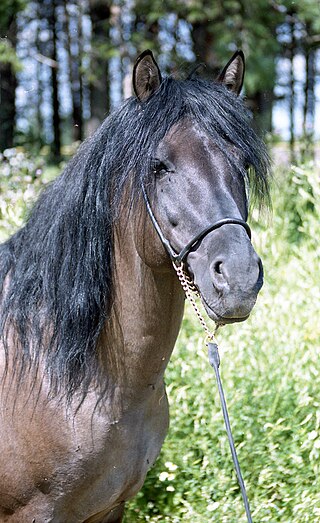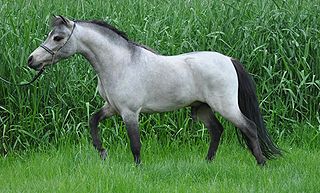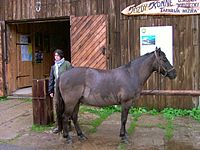
The Konik or Polish Konik, Polish: konik polski, is a Polish breed of small horse or pony. There are semi-feral populations in some regions. They are usually mouse dun or striped dun.

The Vyatka or Viatka is an endangered breed of horse native to the former Vyatka region, now the Kirov Oblast of the Russian Federation. It is mainly found there and in the Udmurt Republic. It is named for the Vyatka River.

The Ukrainian Riding Horse or Ukrainian Saddle Horse is a modern Ukrainian breed of warmblood sport horse. Breeding began in the years after the Second World War at the stud farm of Dnipropetrovsk in central Ukraine – at that time in the USSR – and later expanded to three other state stud farms. It derives from cross-breeding of Hanoverian, Thoroughbred and Trakehner stallions with local mares or with Hungarian Furioso, Gidran Arab or Nonius mares. It incorporates the last bloodlines of the extinct Orlov-Rostopchin or Russian Saddle Horse. It was bred to compete in show jumping, three-day eventing and dressage, but is also suitable as a general riding horse.

The Knabstrupper or Knabstrup is a Danish breed of warmblood horse. It is principally a riding horse, but is also used as a harness horse and as a circus animal. It is broadly similar to the Frederiksborger, but often has a spotted coat. In the past, injudicious breeding for this characteristic alone compromised its constitution and conformation. In the years after the Second World War the mechanisation of agriculture led to a sharp fall in numbers, and by the 1960s no more than 100 of the horses remained. In the twenty-first century it is an endangered breed, with a world-wide population estimated at little over 2000.

The Yonaguni or Yonaguni uma (与那国馬) is a critically-endangered Japanese breed of small horse. It is native to Yonaguni Island, in the Yaeyama Islands in south-western Japan, close to Taiwan. It is one of eight horse breeds native to Japan.

The Dosanko (道産子), also known as the Hokkaido Horse and Hokkaido Pony, is one of the eight extant indigenous horse breeds of Japan, and the only one of the eight not critically endangered. It originated on the island of Hokkaido, in the far north of the country, and is found particularly along the Pacific (eastern) coast of the island. The people of Hokkaido may be nicknamed "Dosanko" after the horses.

The Sokolski, Polish: Sokółski or Koń sokółski, is a Polish breed of draught horse. It is named for the town and county of Sokółka, near Białystok in north-eastern Poland, where it was first bred in the 1920s. It derives from cross-breeding of local Polish mares of Polish Coldblood type with imported Trait Belge and Ardennais stock. It is distributed mainly in the voivodeships of Lublin and Podlasie. It is clean-legged; the usual coat colour is chestnut.
The Poney du Logone is a breed of small horse or pony from the area of the Logone River in Chad and Cameroon, in west central Africa. It is particularly associated with the Musey or Moussey people of that region, and may also be known as the Poney Musey or Poney Mousseye.

The Latvian Horse is a purpose-bred warmblood horse breed from Latvia. Breeding began in Latvia in the early twentieth century, and a herd book was established in 1927. The breed was officially recognised in 1952. There are two types, sometimes called the Latvian Harness Horse and the Latvian Riding Horse. The harness type was predominant until about 1960, when demand for sport horses increased and more of the saddle type were bred.

The Bosnian Mountain Horse is the only indigenous breed of domestic horse in Bosnia and Herzegovina, where it constitutes about 70% of the horse population. It is a small horse and is used both as a pack animal and for riding. Breed numbers were severely reduced during the Bosnian War of 1992–1995, and, unlike populations of other farm animals, continued to fall after the end of the war.

The Karabair is a long-established horse breed from Central Asia, and particularly from Uzbekistan and northern Tajikistan. It results from the cross-breeding of desert horses of Arabian or Turkmene type from the south with steppe horses from the north. It is a small, agile and versatile horse that can be used for riding or driving. It is well suited to local horse sports, and especially to the Uzbek national game, kokpar. It is also used for meat and milk production; the milk may be made into kumis.
The Tawleed is a Sudanese breed of sport horse. It derives from the Sudanese Country-Bred through cross-breeding with imported blood horses, principally of Thoroughbred stock. It is found mainly in the Khartoum region of Sudan.
The Hirzai is a rare Pakistani breed of riding horse. It derives from cross-breeding of Baluchi horses with Arab stock. It is usually grey; other colours occur infrequently. The average height is 152 cm. In the twenty-first century it is an endangered breed.
Western Sudan Pony is an exonym for a Sudanese breed or group of breeds or ecotypes of small horse or pony. These are distributed principally in southern Darfur and south-western Kordofan, extending into southern Chad, and are known generically as Gharbaui ("western") or by a variety of regional names including Darfur Pony and Kordofani.
The Azerbaijan, is an Azerbaijani breed or group of breeds of riding horse of Oriental type. In 2007 it was listed by the FAO as endangered; in 2021 it was not among the horse breeds reported to DAD-IS.

The Silesian Warmblood or Silesian, Polish: Koń śląski, Silesian: Ślůnski kůń, is a Polish breed of warmblood horse. It originates in the historic region of Silesia, which lies mostly within modern Poland. It is the heaviest of the Polish warmblood breeds, and has been influenced mainly by the Thoroughbred and Oldenburg, and partly by the East Friesian and German Warmblood.

The Dongola or Dongolawi is an African breed of riding horse. It is predominantly of Barb type, though there may have been some Arab influence in the past. It originated in the Dongola province of Sudan, for which it is named. In eastern Africa it is distributed in the northern part of Sudan and in western Eritrea; it is also present in several West African countries including Cameroon, Chad and the Central African Republic. A number of local West African breeds or types derive from it; they may be regarded as sub-types, or may be reported as separate breeds.
The Shan Horse or Shan Myinn is a breed of small mountain horse or pony from the Shan Highland, in Shan State in eastern Myanmar (Burma). It was traditionally bred by the Shan people of that area. It is one of two horse breeds in Myanmar, the other being the Burmese Horse. It is similar to the Indian Manipuri, Spiti and Bhutia breeds of small horse or pony.
The Burmese Horse or Bama Myinn is a breed of horse from Myanmar (Burma). It is one of two horse breeds in Myanmar, the other being the Shan Horse.

The American Miniature Horse is an American breed of small or miniature horse. It has been selectively bred to display in miniature the physical characteristics of a full-sized horse, and usually stands no taller than about 38 in (97 cm). It frequently has the appearance of either a small Arab or a small draft horse; genetically it is no different to pony breeds such as the Shetland.




















